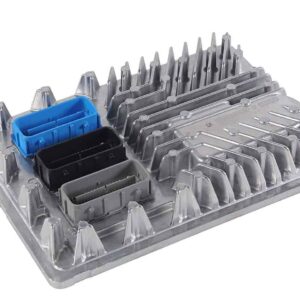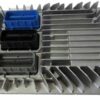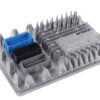Is Your GM Truck or SUV Acting Up? Let’s Get it Fixed.
As a technician with over two decades of experience under the hood, I’ve seen my fair share of perplexing engine issues. If your 2017 Suburban 1500 is suddenly stalling, refusing to start, or throwing a check engine light that won’t go away, a failing Engine Control Module (ECM) is a very likely culprit. This isn’t just a simple component; it’s the brain of your engine, managing everything from fuel mixture and ignition timing to transmission shifts. When it starts to fail, the symptoms can be frustrating and unpredictable.
Case Study: A Tricky Diagnosis
I remember a 2017 Tahoe that came into my bay with an intermittent no-start condition that had stumped two other shops. The owner was at his wit’s end. The vehicle would run perfectly for days, then suddenly refuse to crank. We ran a full diagnostic scan and found a slew of communication error codes (U-codes) that would appear and disappear. After checking the main communication network wiring and connectors, we focused on the ECM. By monitoring the data stream, we caught the ECM intermittently dropping offline, which was causing the entire vehicle security and starting sequence to fail. Replacing the faulty ECM with a properly programmed unit like this one solved the problem for good. It’s a classic example of how a failing ECM can create ghost-like issues that are tough to pin down without experience.
Common Signs of a Failing ECM
A faulty ECM can manifest in many ways. If you’re experiencing any of the following, it’s time to consider a replacement. Keep an eye out for these trouble codes on your scan tool.
- ✔ Vehicle will not start or has intermittent starting issues.
- ✔ Persistent Check Engine Light (CEL) with codes like P0601, P0606, or other processor faults.
- ✔ Unexplained loss of engine power or poor acceleration.
- ✔ Decreased fuel economy.
- ✔ Erratic shifting or transmission problems.
- ✔ Communication errors with other modules (U-codes).
- ✔ Stalling for no apparent reason.
Our Solution: A Straightforward, Reliable Repair
We take the guesswork out of the repair. This isn’t just a part in a box; it’s a complete solution. When you order from us, we flash this genuine GM Engine Control Module with the latest, most stable software updates directly from GM. We use your vehicle’s Vehicle Identification Number (VIN) to ensure the calibration is a perfect match for your specific configuration. This critical step ensures proper engine and transmission function right out of the box, saving you a trip to the dealership for initial programming.
A Professional’s Guide to Installation
Replacing the ECM is a manageable job for an experienced DIYer or any professional technician. Follow these steps carefully for a smooth installation.
- Safety First: Always disconnect the negative terminal from your vehicle’s battery before beginning any electrical work.
- Locate the ECM: On most GM trucks and SUVs like the Suburban, the ECM is located in the engine compartment, typically on the driver’s side near the firewall or fender.
- Disconnect Connectors: Carefully release the locking tabs and unplug the wiring harness connectors from the old module. Inspect the connectors for any corrosion or damage.
- Remove the Old Module: Unbolt the old ECM from its mounting bracket. It’s usually held in place by a few small bolts.
- Install the New Module: Mount your new, pre-programmed ECM onto the bracket and securely fasten it.
- Reconnect Everything: Plug the wiring harnesses back into the new ECM, making sure they click securely into place. Reconnect the negative battery terminal.
- Perform Relearn Procedures: This is a critical final step. You will need access to GM’s Tis2web or Techline Connect service to perform the Vehicle Theft Deterrent System relearn. Without this, the vehicle will not start. Additional procedures like a Crankshaft Variation Relearn may also be required.
Verified Vehicle Compatibility
This module is a direct replacement for part numbers 12692068, 12704476, 12686382, 12674052, 12674472, and 12678815. It is guaranteed to fit the following vehicles:
- 2017 Cadillac Escalade & Escalade ESV
- 2017 Cadillac XTS (3.6L Twin Turbo, VIN 8)
- 2017 Cadillac CTS (6.2L Supercharged or 3.6L Twin Turbo)
- 2017 Cadillac ATS (3.6L, VIN Y)
- 2017 Chevrolet Corvette
- 2017 Chevrolet Tahoe
- 2017 Chevrolet Suburban 1500
- 2017 Chevrolet Yukon & Yukon XL 1500
- 2017 GMC Sierra 1500 & Sierra Denali 1500
- 2016-2018 Chevrolet Silverado 1500 (check specific ID)
- 2016-2018 GMC Sierra 1500 & Sierra Denali 1500 (check specific ID)
Frequently Asked Questions
Do I really need to provide my VIN?
Do I really need to provide my VIN?
Yes, this is absolutely essential. We program the module with GM’s latest software updates specific to your vehicle’s VIN. This ensures all systems, including the engine, transmission, and emissions equipment, function exactly as the factory intended.
What is a ‘theft relearn’ and why is it required?
Do I really need to provide my VIN?
Yes, this is absolutely essential. We program the module with GM’s latest software updates specific to your vehicle’s VIN. This ensures all systems, including the engine, transmission, and emissions equipment, function exactly as the factory intended.
Can I perform the theft relearn myself?
Do I really need to provide my VIN?
Yes, this is absolutely essential. We program the module with GM’s latest software updates specific to your vehicle’s VIN. This ensures all systems, including the engine, transmission, and emissions equipment, function exactly as the factory intended.
What other relearns might be needed?
Do I really need to provide my VIN?
Yes, this is absolutely essential. We program the module with GM’s latest software updates specific to your vehicle’s VIN. This ensures all systems, including the engine, transmission, and emissions equipment, function exactly as the factory intended.
Is this a new or used part?
Do I really need to provide my VIN?
Yes, this is absolutely essential. We program the module with GM’s latest software updates specific to your vehicle’s VIN. This ensures all systems, including the engine, transmission, and emissions equipment, function exactly as the factory intended.



